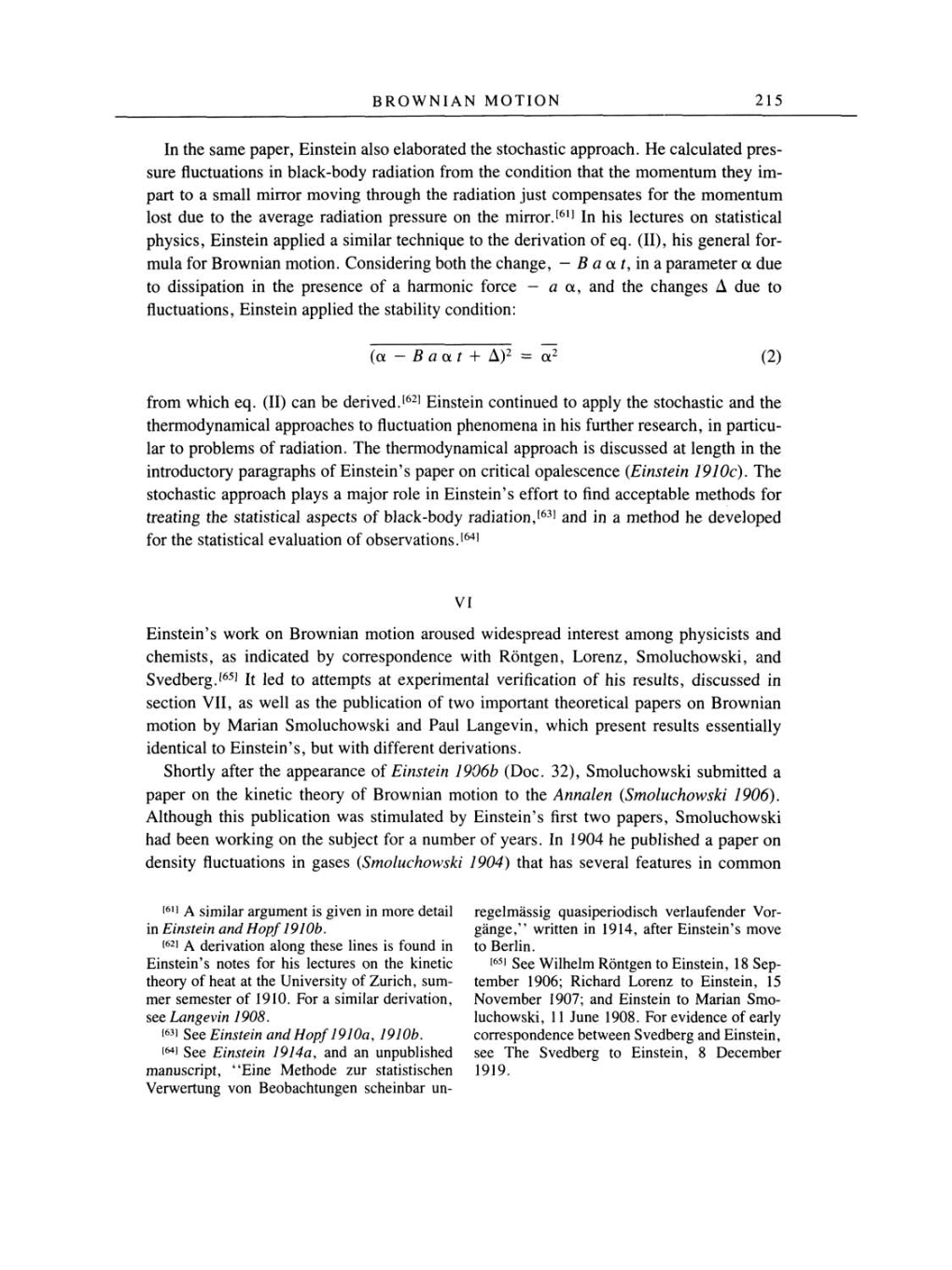BROWNIAN
MOTION 215
In the
same paper,
Einstein also elaborated the stochastic
approach.
He calculated
pres-
sure
fluctuations in
black-body
radiation from the condition that the
momentum
they
im-
part
to
a
small mirror
moving through
the radiation
just
compensates
for the momentum
lost due to the
average
radiation
pressure on
the
mirror.[61]
In his lectures
on
statistical
physics,
Einstein
applied a
similar
technique
to the derivation
of
eq.
(II), his
general
for-
mula for Brownian motion.
Considering
both the
change,
-
B
a
a
t,
in
a
parameter
a
due
to
dissipation
in the
presence
of
a
harmonic force
-
a a,
and the
changes
A
due
to
fluctuations,
Einstein
applied
the
stability
condition:
(a
-
B
a
a
t
+
A)2
=
a2
(2)
from which
eq.
(II)
can
be
derived.[62]
Einstein continued to
apply
the stochastic and the
thermodynamical approaches
to fluctuation
phenomena
in
his further research, in
particu-
lar to
problems
of
radiation. The
thermodynamical approach
is
discussed at
length
in
the
introductory paragraphs
of Einstein's
paper on
critical
opalescence
(Einstein 1910c).
The
stochastic
approach plays a major
role
in
Einstein's
effort to find
acceptable
methods for
treating
the statistical
aspects
of
black-body radiation,[63]
and
in
a
method he
developed
for the statistical evaluation
of
observations.[64]
VI
Einstein's
work
on
Brownian motion aroused
widespread
interest
among
physicists
and
chemists,
as
indicated
by correspondence
with
Röntgen, Lorenz,
Smoluchowski,
and
Svedberg.[65]
It led
to
attempts
at
experimental
verification
of
his
results,
discussed
in
section
VII,
as
well
as
the
publication
of
two
important
theoretical
papers
on
Brownian
motion
by
Marian Smoluchowski and Paul
Langevin,
which
present
results
essentially
identical to Einstein's, but with different derivations.
Shortly
after the
appearance
of
Einstein 1906b
(Doc.
32),
Smoluchowski submitted
a
paper on
the kinetic
theory
of
Brownian motion to the Annalen
(Smoluchowski 1906).
Although
this
publication was
stimulated
by
Einstein's
first two
papers,
Smoluchowski
had been
working
on
the
subject
for
a
number
of
years.
In
1904 he
published a
paper
on
density
fluctuations
in
gases
(Smoluchowski 1904)
that has several features
in
common
[61]
A
similar
argument
is
given
in
more
detail
in Einstein
and
Hopf
1910b.
[62]
A derivation
along
these lines
is
found
in
Einstein's
notes
for his lectures
on
the kinetic
theory
of
heat at the
University
of
Zurich,
sum-
mer
semester
of
1910. For
a
similar
derivation,
see Langevin
1908.
[63]
See Einstein
and
Hopf 1910a,
1910b.
[64]
See Einstein 1914a, and
an unpublished
manuscript,
"Eine
Methode
zur
statistischen
Verwertung von Beobachtungen
scheinbar
un-
regelmässig quasiperiodisch
verlaufender Vor-
gänge,"
written in
1914,
after
Einstein's
move
to
Berlin.
[65]
See Wilhelm
Röntgen
to Einstein, 18
Sep-
tember
1906;
Richard Lorenz
to Einstein, 15
November
1907;
and Einstein to Marian Smo-
luchowski,
11
June 1908. For evidence
of
early
correspondence
between
Svedberg
and
Einstein,
see
The
Svedberg
to Einstein, 8 December
1919.
